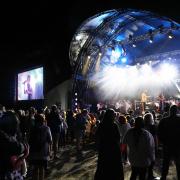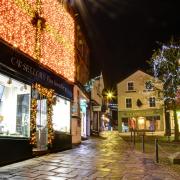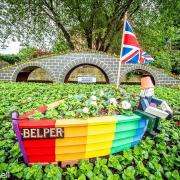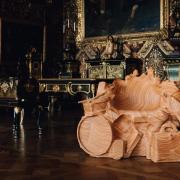Nearly 115 years after the idea for the Victoria County History of Derbyshire was first proposed, the latest volume is published

Miss Wilmot’s letters of enquiry usually received replies which began with the gentle greeting ‘My Dear Cicely.’ And although one confused respondent opened his letter with the words ‘Dear Sir’, everybody who wrote back to this Edwardian lady was making some contribution to a new written history of Derbyshire. It was in the years shortly before the beginning of the First World War that Cicely Wilmot, an Oxford University-educated history researcher, began writing to Derbyshire’s landed families in order to obtain information about their estates and family histories. The aim of her researches was to provide information for a new volume for the Victoria County History of Derbyshire, an ambitious multi-volume publication which would provide definitive accounts of the county’s flora, fauna, geology, industry, pre-history and social and political history including detailed ‘topographical’ histories of every single parish. The great Victoria County History project had been founded in 1899 and aimed to provide all the counties in England with their own authoritative histories which would, collectively, add up to a grand history of the nation in 160 volumes.
To this end editors were appointed for each county and some of the best experts of the age were recruited to write chapters. The editor for Derbyshire (and several other counties) was the editor of the entire VCH project, William Page; his writing team included the eminent archaeologist Francis Haverfield, who wrote the chapter on Roman archaeology; palaeontologist William Boyd Dawkins, who contributed to the chapter on pre-history; and parochial church historian the Rev J.C. Cox, who wrote a chapter on Derbyshire’s ecclesiastical houses.
Under Page’s energetic direction two volumes of the Derbyshire VCH were published, in 1905 and 1907. A third, the ‘topographical’ histories of the parishes, was in hand but never completed. Why? The VCH nationally simply ran out of money. The project was effectively put on hold when the First World War began in 1914 and while further volumes continued to be published, Derbyshire was among those counties which were left with unfinished histories. In Cicely Wilmot’s case this meant that her research, conducted between 1906 and 1910, was to be unpublished, her polite letters of enquiry and the letters she received being filed away and forgotten – until they were rediscovered around 100 years later.
Matters began to change in 2001 when the VCH was revived in Derbyshire. A new fund-raising Victoria County History Trust was formed and work started on researching and writing the parish histories. The very first new volume in the Derbyshire VCH, containing histories of Bolsover and four adjoining parishes in the Scarsdale Hundred of north east Derbyshire, was finally published in December 2013 and officially launched at Clowne Heritage High School earlier this year. Today work is progressing on the next volume in the Scarsdale Hundred series and over time the series will cover parishes of the City of Derby, the High Peak Hundred, Wirksworth Hundred and so on. In total it will take 20 volumes, each of around 250,000 words, to cover every parish in the county.

The VCH county editor who has the task of orchestrating the research and writing of this vast project is professional historian Philip Riden, a former Chesterfield Grammar School pupil who has lectured and written widely on Derbyshire and British history. It was this VCH role which brought Mr Riden into contact with the letters of Cicely Wilmot, whose researches had been directed towards the Appletree Hundred, which covers the parishes of Duffield, Belper and the Dove Valley. In 1939 her letters were among the vast VCH archive that was moved out of central London to the University of London’s Royal Holloway College in Egham in order that they might survive German bombing. It was when the Derbyshire archive was finally handed over to Philip Riden in 2002 that he found the small hand-written letters that she had posted off to various families as part of her research for the next volume of the Victoria County History – a volume that would not be published in her lifetime. The archive also included letters of response, most of which were positive and helpful.
So who was Cicely Wilmot? Mr Riden has researched some aspects of her family tree and discovered that she was the daughter of a Macclesfield headmaster and army chaplain. In those days it was expected that editors of the VCH should not live in the counties they were researching. ‘She seems to have been one or two relatives removed from the Wilmots of Chaddesden in Derby,’ said Mr Riden. ‘They owned Chaddesden House, which was to be demolished in 1926. Certainly, she was writing to the gentry of south east Derbyshire on almost the same level of social equality. She was asking them about their estates and for information which today you would only have to go to the records office to obtain.’ Among the families she also contacted were the Fitzherberts of Somersal Herbert Hall and the Meynells of Meynell Langley Hall. ‘Most of the letters she received began “My Dear Cicely” but there was one which started “My Dear Sir”,’ said Mr Riden. Assumption by this particular respondent that Miss Wilmot was in fact a man may be understandable given the times in which she lived. While Miss Wilmot had passed her finals for a degree in modern history at Oxford University, as a woman she was not allowed actually to take her degree. On the other hand, she was one of many female historians who came to be employed by VCH in its Edwardian heyday before the Great War; indeed, there were so many women working at VCH that there was a complaint about them causing great inconvenience to the general public. Nonetheless, as one of the VCH’s professional researchers Miss Wilmot also wrote several parish histories for Hertfordshire which were published in 1908 and 1912. Quite what Miss Wilmot did during the Great War, when the VCH went quiet, is unknown, so far. However, she appears to have remained unmarried and eventually became secretary to the wife of the Bishop of London. She was also a magistrate.
By the time Miss Wilmot died in Cheltenham in 1958 the society of the Edwardian gentry she had been researching had been all but swept away by the social impact of two world wars. One wonders if she thought her work would ever surface again, be read by a historian many years in the future or become of any use in a history of Derbyshire. Certainly, the way the new volumes of the Derbyshire VCH are being written is far different from her solo efforts. The new VCH volumes, supported by a committee whose president is the Duke of Devonshire, are being researched and written by a team of around 50 volunteers who meet regularly in Chesterfield and Matlock under the guidance of Mr Riden. So far VCH Derbyshire has produced two booklets, on Hardwick Hall and Bolsover (both by Mr Riden and Dudley Fowkes) and one ‘red book’, which is the lavishly produced hardback volume containing the detailed histories of Bolsover, Barborough, Clowne, Elmton and Whitwell. At £95 each, these red parish histories are not a casual purchase; many copies, however, will go onto the shelves of county libraries where they will finally take a place alongside the two thick VCH volumes that were published in 1905 and 1907.
In some ways these older books are still valuable resources for professional and amateur historians. ‘The translation of Domesday in it remains unsurpassed even today,’ said Mr Riden. In other ways these books are now curious time-pieces, frozen in time, their once authoritative text reflecting the style and values of the Edwardian age in which they were written. Nevertheless, Miss Wilmot’s efforts of long ago should eventually see the light of day. She had completed half a dozen Derbyshire parish histories; some had been typed up and were marked for setting by the printer, others were still in manuscript form. But it is extremely likely that they will all be used in the forthcoming VCH ‘red book’ covering the history of the Appletree Hundred.
*The two original VCH Derbyshire volumes were reprinted in 1970. While these are now out of print copies can usually be found in larger public libraries, Copies of the new Vol III can be purchased by contacting the publisher Boydell & Brewer www.boydellandbrewer.com
Further details about the Derbyshire VCH are available at www.victoriacountyhistory.ac.uk/counties/derbyshire.



























